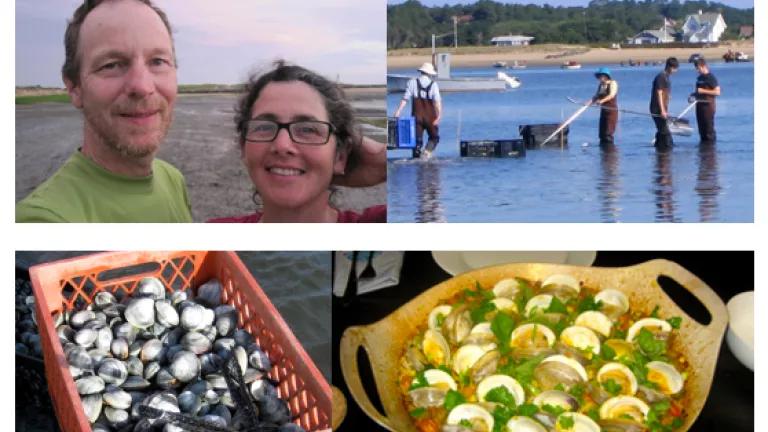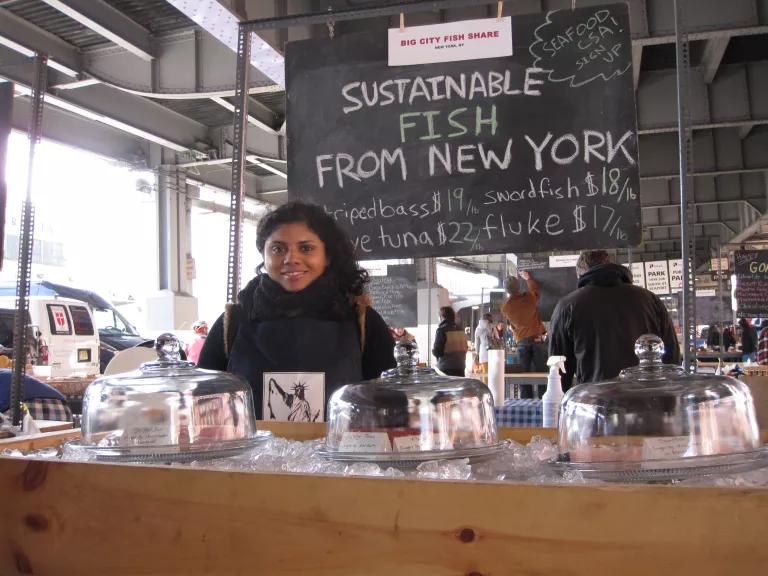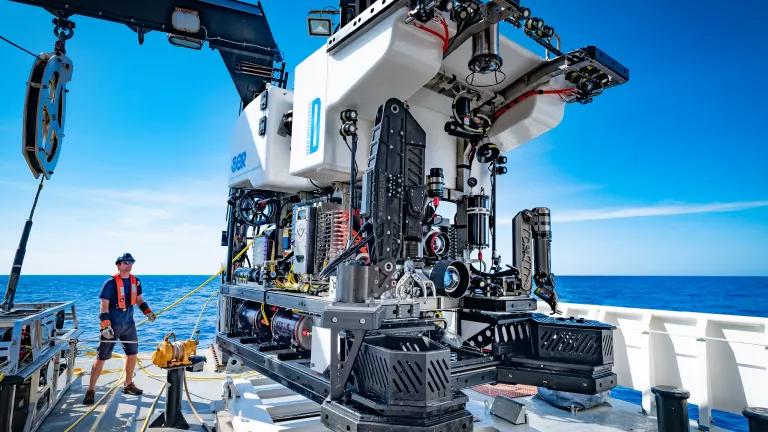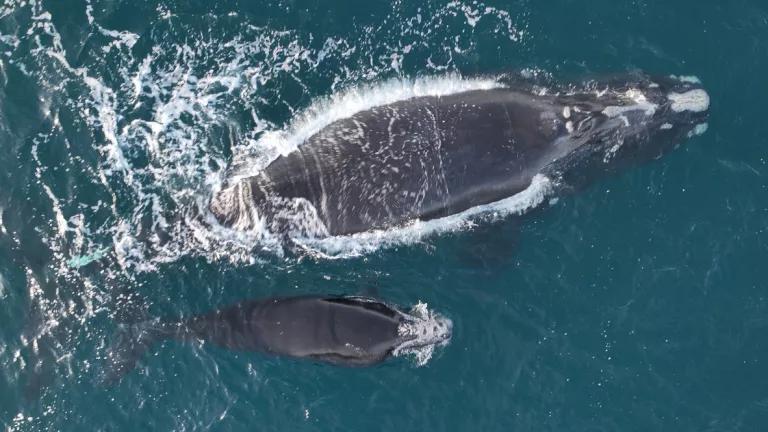
Pat and Barbara Woodbury; Woodbury Seafoods' aquaculture operation in Wellfleet, Cape Cod; freshly-harvested littleneck clams; and clam paella made by Mark Usewicz.
You’ve heard of farm to table? How about sea to plate? Over the past few years, a new fishy cousin of the local food movement has come ashore. It’s the seafood equivalent of the urban farm share, referred to as a community-supported fishery, or CSF for short. At least 30 CSFs have sprung up across the country (visit localcatch.org to find a CSF near you). The concept is straightforward: local fishermen sell their catch to individual consumers, often through a separate organizing entity that handles the transport, processing (e.g., cleaning and filleting) and customer service. It also rekindles memories of a bygone era when local fishermen hauled the day's catch directly to market. Fishermen benefit from a guaranteed market, typically at higher prices than selling through a distributor. In return, CSF members get access to locally-produced fresh seafood, which may also be caught using sustainable and low-impact fishing methods that target only healthy fish populations. In the process, we can reconnect to where our food comes from, how it’s caught, and how our consumption affects the world around us.
The benefits to the fisherman and consumer are pretty clear – higher fixed prices for the former and a regular supply of fresh local seafood for the latter. What’s less apparent is the value of this type of model for the fish themselves. In other words, can CSFs lead to more sustainably-managed fisheries and more abundant fish populations? And, what ethical obligation does a CSF operator have to ensure that claims about the sustainability or eco-friendly nature of their products are backed up by effective procurement policies?
But first, some background on why this matters.
Global marine fish populations are plummeting. Large ocean predators like marlin, tuna, and swordfish have declined by 90% over the past 60 years. According to the U.N. Food & Agriculture Organization, 57% of the world’s marine fish stocks are at maximum exploitation levels and 30% are overexploited. Over the past 25 years, we’ve continued to fish harder and harder (measured by the quantity and intensity of fishing pressure) to catch the same amount of fish, further depleting fish populations (see Charting a Course to Sustainable Fisheries).
By contrast, many American fisheries are beginning to recover from years of overfishing due to stronger conservation standards enacted over the past two decades. According to the National Marine Fisheries Service, more than 27 different fish species have recovered from depletion since 2000, including fluke, bluefish, haddock, and sea scallop. So, even as global fisheries continue to decline, things are improving here at home. But we still import nearly 90% of our seafood, much of which is caught in poorly managed fisheries, especially compared to those in U.S. waters. To compound this, most imported fish are poorly labeled, and the location and method of harvest, two key determinants of the sustainability of the catch, are virtually untraceable. This leaves consumers in the dark concerning the safety and sustainability of most of the seafood we eat and without any sense of whether the people catching it are fairly rewarded. Certification programs, like the Marine Stewardship Council, can help guide us to more sustainable choices, but even these systems have problems. A study last year in Marine Policy, reported in the Washington Post, found that nearly one-third of MSC-certified fisheries were actually at unhealthy population levels. Because of the disconnect in the value chain between consumers and producers, the choice of seafood we buy generally has little to no impact on how fisheries are managed, which prevents the kind of positive feedback loop that rewards the catch of more abundant fish with less bycatch and more benign gear.
This is where CSFs and similar models that directly link consumers and fishermen can make a difference. This linkage allows us to be sure of exactly what we’re buying and where it comes from. It also incentivizes sustainable fishing by rewarding fishermen for targetting more abundant populations. But, to ensure that the fish being served up are what consumers are led to believe, CSFs should adopt clear sustainable procurement policies.
To be fair, some CSFs make no claims about ecological sustainability. Their aim is simply to tap into the demand for local fish and improve the bottom line for fishermen – both laudable goals. However, some CSFs also claim that their fish is sustainably caught even when it’s not. For example, one Massachusetts-based CSF fishing in the Gulf of Maine claims “sustainably-caught seafood” on its website, yet sells members some species of fish with locally-depleted populations, including blackback flounder (a.k.a. winter flounder), grey sole (a.k.a. witch flounder), and yellowtail flounder. According to the National Marine Fisheries Service's most recent report, these three stocks in the Gulf of Maine are between 24-41% of their sustainable biomass – well below the overfished threshold.
In my hometown of New York City, there are now three CSFs with multiple pick-up locations around town. The one my wife and I joined last summer, called Mermaid’s Garden, was launched in May of 2012 by Bianca Piccillo, an ichthyologist with a keen business savvy, and Mark Usewicz, a French-trained chef with a refined list of superb seafood recipes. For a fixed price of $16.50 per week, Mermaid’s rich network of fishermen and shellfish producers has provided some of the freshest and highest quality seafood we’ve ever had – anywhere – and it’s all local and sustainable. This delectable menagerie has so far included bluefish caught by a 14th-generation pound-net fishermen, “Montauk Pearl” oysters, hook-and-line caught striped bass, sushi-quality yellowfin tuna, day-boat scallops, North Atlantic swordfish, golden tilefish, summer flounder, Cape Cod steamers, rope-grown mussels from Casco Bay, Maine, and Wellfleet littleneck clams from Woodbury Seafoods.
Mermaid’s Garden is just as serious about the sustainability of their catch as they are about quality. They have signed the Common Vision for Environmentally Sustainable Seafood from the Conservation Alliance for Seafood Solutions, a coalition of leading conservation organizations in the U.S. and Canada (of which NRDC is a founding member). Bianca and Mark evaluate the health of the populations they source from and the type of fishing gear being used to ensure that the catch is not overfished or depleted according to the latest status reports from the National Marine Fisheries Service. Mark reports that Mermaid’s members (they've got more than 200 and growing) are “so happy” with the product, which is more than he can say as he prepares the weekly catch with his “hands deep in a vat of iced fish.” Their fishermen, whom they deal with personally, are also happy to sell fewer fish for more money per pound than they would typically get at auction, according to Bianca.
A second CSF in NYC, named Village Fishmonger, was launched in September of 2012 by Samantha Lee, Dennis O’Connor, and Sean Dixon, three friends frustrated by the lack of local, responsibly-harvested seafood options in NYC. Village Fishmonger now has over 100 members with five pick-up locations in Manhattan and Brooklyn. Sourcing product from a cooperative of fishermen in Barnegat Light, NJ, Village Fishmonger promises its members “local, responsibly-harvested fish and shellfish.” With a policy similar to that of Mermaid’s Garden, Village Fishmonger also pledges not to source fish that is currently listed as overfished or subject to overfishing by the National Marine Fisheries Service or the Atlantic States Marine Fisheries Commission. Village Fishmonger provides an updated list of which species and particular stocks it considers healthy, giving both its members and fishermen a transparent, clear guide for what fish it’s procuring and why. In addition, Village Fishmonger’s weekly members-only guide contains a wealth of information – from recipes to the name of the boat, captain, and location along the Mid-Atlantic bight from where the fish were captured.

Big City Fish Share stand at New Amsterdam Market.
A third CSF, named Big City Fish Share, was recently launched by Matt Gove, a policy analyst with NY State’s Department of Environmental Conservation. Big City Fish currently purchases its fish from a seafood buyer on the East End of Long Island, not directly from the fishermen. The operation is still quite small, with only about a dozen members, and it’s unclear whether it has the capacity to begin sourcing its products directly from fishermen, which is a key prerequisite to rewarding fishermen with a premium price for sustainably-caught fish.
Another great location for local seafood is the New Amsterdam Market, located near the old Fulton Fish market in downtown Manhattan, which convenes local food purveyors on Sundays from spring to autumn, including a number of local fishmongers. This is where I connected with the Iliamna Fish Company, a CSF linking members in Brooklyn, NY and Portland, OR with some of the finest deep red Alaskan sockeye salmon. The family-operated company is named after Lake Iliamna, which is the largest freshwater lake in Alaska and the terminal spawning grounds of the salmon it fishes in Bristol Bay.
Unfortunately, the entire Bristol Bay ecosystem is currently threatened by the proposed Pebble Mine project, which would be the one of biggest open-pit gold and copper mines in the world right smack in the heart of the headwaters of the largest sockeye salmon fishery in the world. Here’s a video from Iliamna Fish Company's Christopher Nicolson explaining why Pebble Mine would be a disaster for the fishery.
NRDC has been working for years to Stop Pebble Mine from destroying this pristine ecosystem and its invaluable source of wild, sustainable fish. President Obama is now considering using his authority under the Clean Water Act to stop the mine. To learn more, watch this video from Robert Redford, and then send President Obama a message opposing the project.
Wild fish not only provides a healthy source of protein and essential fatty oils, but also nourishes our connection to the vibrant underwater world of the sea. Wisely choosing which fish we eat respects the natural processes that sustain us from one generation to the next. Like the hunter who honors his kill with the quiet acknowledgement of the sacrifice, we reconnect with a universal and timeless cycle of life.



